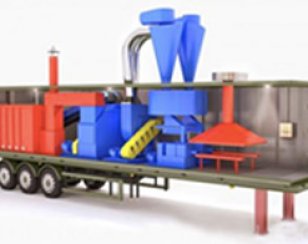Getting fibers of annual plants.
Bast fibers are plant fibers, received from the stems and leaves of plants. Plants, cultivated for getting the bast fibers, called bast crops. Bast plants containing fibers in the stems are long-fibred flax, hemp, kenaf, jute, China grass, abutilon, kendyr, pea bush, sida and others. Bast plants containing fibers in the leaves are agave, New Zealand flax, spinning banana (abacus), yucca and others. During the primary processing as a result of pressing and scutching of retted and dried stems hemp came out of it. Traditionally, for the release fibers stems are exposed to the primary - biological processing (retting) and the secondary - mechanical (pressing, scutching) processing. The task of the entire processing cycle is to get a trust from hemp, and from the trust - the fibers.
Trust is the straw of flax, hemp, and some southern fiber bast crops (jute, kenaf), processed with biological, thermal or chemical techniques. Processing with these techniques pectic substances, bonding timber and cover with fibrous bunches, are destroyed. They receive from trust fibre for spinning by mechanical way (pressing, scutching, hackling) and scutch. Scutch is lignified parts of stems, received as waste during primary processing (pressing, hackling) of flax for the release fibers of the trust.
The purpose of the biological, thermal or chemical exposures to hemp is the destruction of substances binding fibers, and receipt trust. As a rule, this is done by using wet processing of hemp with the addition of reagents.
They dry trust for further processing to necessary moisture in the dryer. The drying of trust before processing is necessary, because the highest outlet of long fiber and its good quality are obtained only under certain conditions of humidity. For example, flax fiber, when it’s moistened, behaves differently than most other fibers. If the increase in moisture makes many fibers lose strength, the flax fibers, on the contrary, with the increase in moisture of 10-13% get stronger.
Dried a little trust is exposed to mechanical stress in order to separate the fiber from the scutch, realizing the following operations:
- pressing: trust is passed through corrugated rollers, thereby destroying the fragile wood, but preserving the elastic fiber;
- scutching: they repeatedly hit trust by the blades of beater drums;
- shaking: sloughing scutches are moved off at shake willow Pressing (compression) and scutching (disruption) are the operations of mechanical exposure to the material, which are executed on traditional equipment.
Specialists of "Research and Production Company “Parmatech" offer to use aerodynamic dispegator for combining the operations of drying and destruction of trusts to fibers. The drying efficiency is achieved by an intensive mass-air exchange, and as a result of features of destruction of fibrous material in the intensive air flow , the division of single fibers and scutches takes place.
In 2011, two receiving plant fibers experiments were made. Wheat straw as a raw material was used. In conducting the first experiment in September 2011 were processed wet straw, as a result of the unit were obtained dry fiber. For the second experiment in November 2011 and processed dry straw, as a result of the resulting product contained a single fiber and destroyed parts of straw. Experiments showed the possibility of plant fibers of annual plants in the aerodynamic Dispersants pre-treatment of raw materials to reduce the action of chemicals that bind fibers. The results of processing of dry wheat straw.

